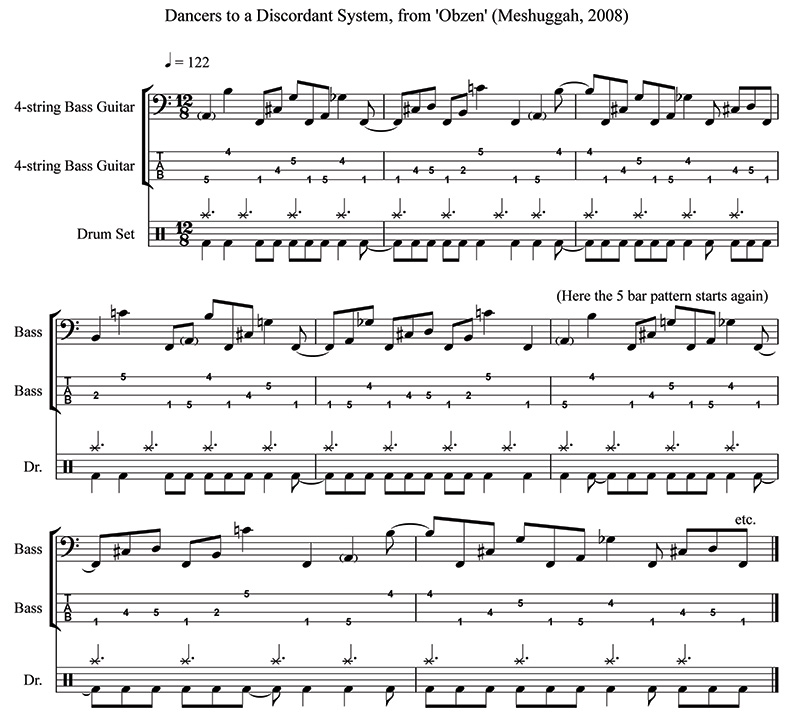Deep Thinking: Polymetric Basslines
Deep Thinking: Polymetric Basslines
In this issue we are going to look at polymetric basslines and drum patterns that have been recorded by two bands described online as ‘progressive’ or ‘extreme’ metal. Whether those are accurate descriptions of them is up to the listener but in the work I’m doing for my new book on progressive rock (shameless marketing!), the term ‘progressive metal’ seems to be used quite a lot, along with a term neither band likes – djent.
Both of these tracks use what is called ‘polymetre’ – in other words, while a track is in one seemingly basic time signature, band members play in different times that meet up at various points in a song. The first example comes from TesseracT’s 2015 album ‘Polaris’. It is a rhythmic analysis of what the band plays on the track Cages. The drums’ main part from 1-55, when the bass enters, consists of measures of 16/8, 16/8, and 14/8. From a mathematical perspective, the emphases (in bold) played by the drums are as follows:
1 2 3 4 5 6 7 8 9 10 11 12 13 14 15 16 (or 4×3 + 4)
1 2 3 4 5 6 7 8 9 10 11 12 13 14 15 16 (or 4×3 + 4)
1 2 3 4 5 6 7 8 9 10 11 12 13 14 (or 2×3 + 2×4)
The bass drum best indicates the phrasing. Mathematically, this adds up to same 46 8th notes of the 11/8, 12/8, 11/8, and 12/8 in the guitar part, but with intricate cross phrasing between the two.
The bass follows the same pattern as the drums, linking with the bass drum. From 3-13, while the drums play a steady 12/8 groove until the end of the song, a distorted guitar and bass riff takes over from the clean guitar part (in 11/8 and 12/8) playing a riff constructed from measures of 15/8, 15/8, 15/8, 15/8 and 12/8. This equals 72 8th notes and corresponds with six 12/8 measures played by the drums. The total number of beats is thus the same – 72 8th notes played by each instrument.
This relationship continues until 4–47 at which point the drums continue in 12/8, whereas the guitar and bass play a distorted figure through 12 measures of 15/8, which equals 180 beats corresponding with 15 bars of 12/8 drums, which also equals 180 beats. Quite a feat of musical mathematics while the vocalist sings across it all! Have a listen on YouTube.

The second example is a track from Meshuggah, Dancers to a Discordant System. On this track, drummer Tomas Haake is basically doubling what the bass player, Dick Lövgren is playing but the interesting thing is that, while the metre seems to be a relatively simple 12/8 pattern, the melodic phrasing is constantly displaced meaning the A, B, F, C#, G etc. phrase occurs in different places each time it is played, as well as in different note lengths.
(BTW, the band use eight-string guitars and the five-string bass is tuned a semitone lower than standard tuning, with a bottom string tuned to a middle F to cut through the guitars. I have transcribed this in A to simplify matters.)
I’ve put brackets around the A at the beginning of each of these phrases. The phrases themselves are five bars long, unlike much non–progressive music (or whatever you want to call it, not going there!) that uses multiples of four bar groupings. It is significant that Haake plays a solid four beats to each bar on the hi-hat while the snare and bass drum are as complex as the guitar and bass parts. This keeps the whole band on track.
Meshuggah were in NZ in March, so I expect that some readers will have seen them. Anyway, have fun trying out some polymetres in your band, it works well in metal and jazz styles, in fact, anything experimental. Just keep counting until you feel the unusual rhythms as a groove!
Dr. Rob Burns is an Associate Professor in Music at the University of Otago in Dunedin. As a former professional studio bassist in the UK, he performed and recorded with David Gilmour, Pete Townsend, Jerry Donahue, Isaac Hayes, Sam and Dave, James Burton, Ian Paice and Jon Lord, Eric Burdon and members of Abba. He played on the soundtracks on many UK television shows, such as Red Dwarf, Mr. Bean, Blackadder, Not the Nine O’Clock News and Alas Smith and Jones. Rob is currently a member of Dunedin bands Subject2change and The Verlaines.

